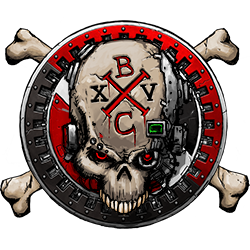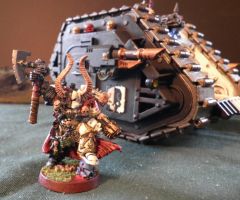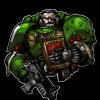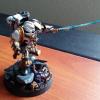Search the Community
Showing results for tags 'Malal'.
-
Khorne, Nurlge, Slaanesh, and Tzeentch. You know them well, you know what they represent. They are the four most well known Gods of Chaos, warp entities bent on ruining everything, and corrupting the material galaxy with their daemons. But they surely aren't the only godly entities floating around in the warp. There are other gods that have appeared in Warhammer that could definitely be reconsidered, adapted, and expanded upon in the Grim Darkness of the future: Renegade Chaos Gods. The other chaos gods who hate the main ones. And so this is to give them their time in the limelight for a change, and come up with some new lore for them. So here is my reinterpretation of the three known renegade chaos gods. Malal - The Malicious Laconic Malal is a deity who represents anarchy, paranoia, renegation, hatred, phobia, prejudice, revenge, enmity, infighting, and other forms of malice and ill will. Champions of Khorne fight for the sake of fighting, wheras a champions of Malal will always have a very specific purpose in mind. Malal was once a Chaos God proper, but he would come into conflict with the other Chaos Gods, although whether it was out of their fear against him that they struck, or his fear of them that it was he, he would end up cast from their pantheon. And what did he do? He would form a new pantheon of his own. (Without blackjack and hookers, that's Slaanesh's thing.) And this pantheon was solely made to advertently cause harm to the rest of chaos. Avatars and Daemons Malal most often takes the form of a horrid, reptilian, draconic entity, wreathed in shadow. Around him, color ceases to exist, everything becomes black and white. His daemons often resemble smaller, weaker versions of his avatar, as they share many traits, like horns or scaly skin. I mean, hey, he's the god of malice, not the god of originality. Anyway, his daemons are particularly known for fighting with other daemons, but when no other daemons are around to fight, they'll attack mortals, and if no mortals are around, they'll turn on each other. That's the chiefest flaw in his domain. There's always an enemy, always something to turn against. Mortal Servants Malal is served by many a Chaos Cultist who realizes "Hey, maybe this isn't all it's cracked up to be." worshiping one of the main four, and wants out. And so even at the best of times, a Chaos Warband of Malal is disjointed and has poor internal chemistry, due to these varying origins. But they are all united against the rest of Chaos, so that keeps them mostly in check. At least one Chaos Space chapter, known as The Sons of Malice. This chapter acts almost as a Chaos version of the Grey Knights, in that it fights daemons and other chaotic threats. The colors of Malal are Black and White, with silver or iron metallics. Nehoco - The Dubious Laconic Nehoco is the god of doubt, of disbelief, of hypocrisy, and of the rejection of the supernatural entirely. He arose from much of humanity's blindness to the supernatural, and the growing power of Chaos and their incursions into the material world harms him. He is a paradoxical being through and through, antithetical to himself. Avatars and Daemons Nehoco appears most commonly as an elderly human man, with wrinkled skin, grey hair, and black voids where his eyes should be. His servant daemons are very rare, but when they do manifest, they are often take mundane forms, they might imitate Humans or Eldar, but they are still wholly demonic, merely disguised. He has no distinct color pattern to speak of. Mortal Servants Nehoco despises any mortal who knows of him, much less a mortal who worships him and tries to spread his name in any way. No, he refuses to have any mortal worshippers. All of humanity worships him by not worshiping him, by not worshiping Chaos at all. There are few exceptions to this rule, the only times he ever does call upon cultists or marines is when he feels he must eradicate knowledge of himself or another god located in the material realm, in which case, his color is a very boring grey. Zuvassin - The Malformed Laconic Zuvassin is the god of errors, mistakes, misfortune, failures, deformations and undoings. Zuvassin was an artificial creation, an attempt by Tzeentch to expand the powers of Chaos by generating a new Chaos god from the depths of the warp. But the experiment went wrong on a cosmic level, and inevitably so. Zuvassin is a mistake on every level, and one that suffers constantly as a result of his basic nature. And he wants revenge for that suffering. He works constantly to spread his corrupting influence wherever he can and to unravel everything the gods have planned. Avatars and Daemons Zuvassin's avatar is a misshaped mass, congealed into a barely cohesive form, much less a comprehensible one, which he shrouds under a heavy robe. His daemonic spawn only reflect a fraction of his misshapen corpus, masses of tentacles, teeth, wings and tongues, slimy puddles of primordial ooze, beings bent and malformed. They exude an aura of failure and misfortune around them wherever they go. Mortal Servants Zuvassin's mortal servants, the few who would devote themselves to such a pitiable entity, are cursed with his misfortune. They rarely succeed when attempting to form cults or warbands, they end up collapsing and devolving, becoming inherently flawed or unstable. Most successful servants of Zuvassin are inevitably used as kamikazes against other chaos cults, entering them and spreading his corrupting influence, only a scant few are truly given his blessing, such that they can last long enough to spread his will further, although they tend to look deformed or melty at minimum. His color is a sickly orange, sometimes with tinges of purple. Some Questions Answers, right off the bat: - Why no Hashut or Horned Rat? Species gods to a species not present in 40k, and they were never really renegade either. - Why no Ynnead, Tau'va, Gork, Mork? They are species gods who might work with each other if need be, but not with the main Chaos Gods or Renegades. - Why no C'Tan? They aren't Warp Gods, they are Material Gods, there's a big difference. - Why no Smiling God-Child? What is that kid even the god of? Mischievous glee? Who knows, maybe. - Why no GEoM? He's still kind of alive? And he would never work with these guys, for obvious reasons. Do you have any ideas below? Feel free to contribute however you see fit! (Even if it's telling me that my idea is lame, that's still contribution, lol)
- 22 replies
-
From the album: Sons of Malice
Sons of Malice Lord -
“What wins the fight is what wins the fight. Ultimately, nothing should be excluded if that exclusion leads to defeat.”- Roboute Guilliman At first glance, the Black Hammers Chapter appear to be the archetypal Traitor Marines; grimy, ancient warriors clad in baroque power armour decorated with furs, trinkets and chaotic litanies, marching under the myriad icons of the fell powers. However, beneath this dark surface the Black Hammers view themselves as the very opposite, as the eventual destroyers of Chaos and the saviours of Humanity. Origins: The tale of the Black Hammers begins in dark days of the Horus Heresy, deep beneath the ruined, irradiated surface of the planet Calth. Tor Agamon, a Brother of the 19th Company of the Ultramarines Legion, had survived the Word Bearers' initial act of treachery and joined the other Loyalist survivors beneath the planet's surface as they battled against the hated sons of Lorgar. Even as Agamon fought, theoreticals tumbled over and over through his mind. The Ultramarine victory had been borne of pure luck, the Word Bearers should have crushed their former brothers. But how had Lorgar's children become so capable, so mighty, that they could so nearly defeat the best trained and most numerous Legion in the Imperium? Brother Agamon had identified only one possible factor; the unknown creatures who seemed to come from the Warp itself. These beings had aided the Word Bearers, given them strength and focus beyond their own reach. Why and how they had done so, Tor had not known, but he was determined to find out. Guilliman himself had taught his Legion; 'Information is victory', so Agamon devoted himself to understanding his enemy. Unbeknownst to his brethren or his superiors, he began to collect and study weapons, armour and other paraphernalia he was able to take from fallen Traitor Marines during Calth's Underground War. Over the following decades of the Scouring, even as Agamon won honours in battle and promotion through the ranks of the Ultramarines, his obsession with comprehending and negating the power of Chaos continued to grow. By the time the Primarch divided the Legions, Agamon had attained the rank of Master and was given command of 1,000 Ultramarine warriors clad in freshly painted black armour. He named them for his only desire, to hammer to extinction the traitors that cowered within the Eye of Terror. Agamon led his fleet to the Segmentum Obscurus, patrolling the Sectors surrounding the Eye like a coursing hound searching for its prey. For long years the Black Hammers fought against the forces of Chaos wherever they could bring them to battle and Agamon instilled in his warriors a hatred but also a healthy respect for the fell powers of the Great Enemy. Homeworld: While chasing down a warband of the Emperor's Children, the Black Hammers discovered Gruaimach, a feudal world on the northern edge of the Great Eye. The people of Gruaimach were primitive, grouped into clans and tribes, their fighters warring and raiding against one another to control their home's few resources. However, it was not their aggression or battle skills that made Master Agamon decide to take the world for his own. Rather, it was that he had uncovered on Gruaimach a culture that had somehow found a way to survive despite its close proximity to the raw, ever-warping power of Chaos. The clans fearfully venerated what they called the 'Chinnidh de na Diathan', a terrifying assemblage of divine creatures that Agamon was immediately able to correlate with what he had already learned of the greater Pantheon of Chaos. The Gruaimachii elders had learned to appease and mollify the Gods, turning away their anger with sacrificial offerings and protecting themselves with shamanistic charms and totems. They had come to understand in a limited way the contrary and divided nature of the warp, how one might protect themselves from the fury of one aspect of Chaos by appealing, even temporarily, to its opposite. Agamon was enthralled by the prospect of learning from the wise men of Gruaimach, of using their knowledge to protect his Chapter and Humanity. Without explaining any of these dangerous thoughts to the Imperial authorities, he claimed the planet as the Black Hammers' own. While initially tight-lipped and unwelcoming towards the giant Astartes, the leaders and shamans of Gruaimach quickly saw the advantage of having such titans as their protectors. They also perceived the eagerness of Master Agamon and his followers to learn of their culture and traditions. In a few scant months, as the Chapter continued in its campaign against the forces of the Traitor Legions, it became commonplace to see Black Hammers Astartes going into battle wearing armour adorned with placatory votive offerings or tokens, or graven with protective charms and warding sigils. At the same time, Chapter Apothecaries had begun to do their work of initiating new brethren from the Gruaimachii clans into the Hammers' Companies, tying the world and its new overlords ever closer. It was less than half a century later, while fighting in a joint campaign against the vile Death Guard, that the Ultramarines and their Successors would first discover the changes in their Black Hammers brethren. They were horrified by the appearance of the black-clad Astartes, their armour decorated in a manner that seemed to many reminiscent of (and scarcely less disturbing than) the equipment of the Word Bearers at Calth. Tor Agamon and his men were shunned by the other Chapters and, after a blistering argument with the campaign's overall commander, the Black Hammers pulled out and returned to Gruaimach. Two months later, a punitive force comprised of no less than four full Ultramarines Successor Chapters, led by the Primarch himself, arrived at Gruaimach. Guilliman and his troops were prepared for a bitter siege, their hearts hardened to the possibility of fighting brother Astartes by the long years of the Scouring. What they found was an empty world, devoid of human life but for a few scattered tribespeople. The Black Hammers fortress monastery, it's basic structure only recently completed, had been stripped back almost to the bare foundations. Tor Agamon, ever the strategist, had foreseen what the response of his peers and Primarch must be, as well as the end result of any attempt to stand against them. However, he was unwilling to lose the precious knowledge that could be the salvation of Mankind, simply because of the prejudiced ignorance of others. Therefore he had ordered that his Companies gathered whatever they could, including as many of the Gruaimachii as could be carried in the holds of the Chapter Fleet, and flee. Gruaimach died that day in the fires of Exterminatus. At the behest of unknown individuals within the Adeptus of Terra, all records of the Black Hammers Chapter were likewise scorched from Imperial history. The scions of Ultramar pursued Agamon's forces across the wilderness between worlds, unrelenting in their hatred for what they saw as a betrayal as great as any of the Heresy. The Black Hammers were hunted from system to system, their beleaguered fleet eventually turning to the only refuge it had left, the Eye of Terror. Organization: One of the Chapters' earliest battles within the Empyrean was to secure a base of operations from which Tor Agamon could continue his research into the mysteries of the Warp. His choice was the Custos Pertinax, a powerful Star Fort, assigned to the World Eaters during the Great Crusade and dragged into the Eye as the Traitor Legions were forced to retreat. However as time passed, few of Khorne's chosen had been willing to accept garrison duty while their brothers rampaged across the stars, leaving the otherwise mighty fortress poorly defended. When the canny Master of the Black Hammers learned this, he quickly threw the entire strength of the newly arrived Chapter against the fortress, overthrowing its remaining occupants in a furious, week-long battle. After this, Agamon took the Custos Pertinax and hid it away in an unimportant star system deep within the Eye. With the aid of his Techmarines he strengthened the Star Fort's Geller Field and Void shield generators. With the aid of the Chapter Librarium and the wise men of Gruaimach he wrapped the vast station about with prayers and spells of warding, misdirection and concealment. With these mystic defences solidly in place, the Black Hammers would have a home from which to continue their work. Nearly ten millennia have passed since the Black Hammers fled into the Eye. In that time the Chapter has grown strong, moving beyond the strictures of the Codex, and it is estimated that they could muster at least sixteen Companies worth of Astartes warriors, with sufficient fleet assets to deploy them with ease. The Black Hammers Armoury is less impressive, consisting of fewer ground-based fighting vehicles than an 'average' Loyalist Chapter. However the Hammers offset this lack of heavier support with the presence of large numbers of non-Astartes auxiliaries, selected from the former population of Gruaimach. While these clan-born troops cannot compare individually with the Chapter's Marines, they are nevertheless capable soldiers as well trained and equipped as the graduates of any of Ultramar's Battle Academies. Powerful though the Chapter's resources are, they are minimal when compared with some of the other forces who call the Eye of Terror home, in particular those Traitor Legions who have maintained a central command structure and power base. Therefore, Master Agamon made pacts of mutual support (or at least of non-aggression) with the Black Legion, Iron Warriors and the Thousand Sons, as well as with the Lords of various Dark Mechanicus strongholds. The Black Hammers have ever refused any alliance with the hated Word Bearers Legion, their warriors simply unable to forget the treachery at Calth. Oddly, the scions of Lorgar seem unconcerned by such hatred, rumour even suggesting that the Daemon Primarch himself views the Black Hammers with a certain black amusement, perversely pleased by the thought of the sons of his brother Guilliman turning against their father. Beliefs: The core beliefs of the Black Hammers Chapter are those of their leader, Tor Agamon. From the earliest days of the Heresy, Agamon believed that the only way for Mankind to be saved from the horrors of the Warp was knowledge. Knowledge of the true nature of the Gods; their strengths, their weaknesses, their goals, their motivations. ”No man is forced to worship the gods, but only a fool fails to give them their due.” Tor Agamon His studies before and after arriving on Gruaimach brought him to one inescapable conclusion: Chaos was both perfectly balanced and yet inherently self-destructive. He further realised that a prudent, careful man could use this fact to his advantage, that when endangered by one aspect of the Great Pantheon he could find protection, or even vengeance, by temporarily invoking its opposite. The only danger of such a course lay in drawing too much attention, of becoming entangled by any of these fell powers, the result of which would surely be an eternity of madness and servitude. Agamon's followers have learned from their Master, though they hide it well from the other denizens of the Eye. The Black Hammers secretly see themselves as Mankind's only true hope for salvation from Chaos. They believe in using the Empyrean, turning its power against itself. Chapter brethren march into battle beneath the icons of Dark Gods, channeling their blessings even as their charms and litanies protect them from the harmful effects of such attention. They also seem to view the colour white as lucky or protective, as many brethren choose to repaint sections of their armour before going into battle, in stark contrast to the black that names them. The Black Hammers walk a deadly tightrope, as it is all too easy for a warrior to become ensnared by the lure of power that Chaos gives. If a Marine does fall in this way, he will be destroyed without mercy, having become the very thing that the Chapter hates above all else. Remarkably, it seems that the majority of the Black Hammers continue to escape this fate. The Hammers themselves claim that such resilience against the effects of Chaos shows that their ideology is the course of wisdom for all of Mankind. However, an observer with a deeper understanding of the truth of the Empyrean might suggest that no amount of crude charms or litanies can turn away the power of Chaos. They might further imply that the Black Hammers are in reality already lost, protected by some unknown God for its own purposes or caught up in some self-destructive undercurrent within the swirling flows of Chaos. Combat Doctrine: Despite the Black Hammers turning their backs on the Imperium, their combat doctrine has continued to follow the pragmatic and adaptable combined arms approach espoused by their gene-father. The Chapter's forces tend towards flexible units of infantry, well equipped to face a multitude of different targets. These units work together as precisely coordinated, mutually supporting battle groups, equally able to defend or advance as needed. A handful of vehicles, most typically basic Predators and Dreadnoughts, will provide heavier firepower and units of Gruaimachii clansmen act as light auxiliaries and scouts. The Confrontation at Tybur-Al III Amongst the elite of Tybur-Al's secondary Hive, a cult dedicated to the Prince of Pleasure arises. Even as the heretics begin to enact their perverse coup, a Strike Cruiser bearing the black and white of the Black Hammers appears in orbit. Most of the Traitor Astartes strike at the primary Hive, but a small force led by a coterie of Sorcerers infiltrates the second, carrying with them the Spear of C'harak. This ancient blade contains within it the bound essence of a mighty Bloodthirster of Khorne. The Sorcerers plant the Spear in the Hive's central plaza and retreat. Likewise, after a brief battle with minimal casualties on either side, the Black Hammers main contingent pulls back to their transports. As the Strike Cruiser departs from Tybur-Al, the wards binding C'harak loosen and break. With a bellow of rage, the freed Bloodthirster smells the hated servants of his master's greatest foe and goes out to do battle with them. Over the next three days, the Greater Daemon of Khorne decimates the Slaaneshi cultists, hunting them down one by one in an orgy of furious bloodshed. Though the Black Hammers rely primarily on their own strategic and tactical prowess, they also make use of the more esoteric resources available to the followers of Chaos. Warriors carry all manner of arcana, some intended to beseech the aid of the Gods but far more to hold off the negative effects of their attention. The summoning of the capricious creatures of the Empyrean is avoided where possible, and the acceptance of possession by them is refused at all cost. However if such beings can be safely bound, often into weapons, vehicle systems or other objects, where the process of binding creates a greater degree of control, then the Chapter will countenance their use. The Chapter often targets other smaller chaotic or renegade forces. This is seen as nothing unusual by the powers-that-be, as warbands all too frequently attack one another for control of resources or to honour their patrons. The Hammers also raid into real-space, ravaging Imperial worlds along the borders of the Eye. Sometimes these are genuine missions to secure needed supplies, sometimes their brutal violence is simply part of maintaining their appearance as devout Chaos worshippers or fulfilling pacts made with other forces. However, on occasion the Chapter is able to use these raids to attack their true enemy. In more instances than can be considered a coincidence, the Black Hammers have decimated a seemingly loyal world, only for Imperial authorities to discover in the aftermath that the planet in question had become the home of Chaos cults, in many cases on the verge of open rebellion. Geneseed: The geneseed of the Black Hammers is that of Roboute Guilliman. In the few cases that bodies of Marines of the Chapter have been examined by the Adeptus Biologis, these remains have displayed a remarkable lack of the mutation and warping so typically seen among the Traitor Legions. Whether this is due to the absolute purity of the Ultramarines' genetic material, the successful protection of the Black Hammers ritual offerings and charms, or even the blessing of some unknown Chaotic benefactor, is unclear. A further benefit of this lack of mutation in the Black Hammers genetic material is that their rate of successful geneseed implantation is far, far higher than that of most chaotic warbands. This means that it has been easier for the Chapter to maintain - and even incrementally increase - its numbers over the millennia, despite the battlefield losses that are common to all renegade forces. Battle Cry: The Black Hammers have no specific war cry, but will often march into battle mumbling Gruaimachii prayer-chants that either request the aid of the Gods or attempt to deflect their notice.
- 22 replies
-
- Chaos
- Lysimachus
-
(and 1 more)
Tagged with:
-
A friend and I have been wanting to start a Sons of Malice/other Malice following army for a little while now. With some paychecks and probably some Christmas money coming up, I'm thinking about finally starting it up. As for building the army, I have a few ideas about how to get started, depending on the look I want ot go for, and was hoping ot get some ideas and opinions from you all. Option number one: Dark Imperium box set. Pros:This would allow me to go for the True Scale look with the force, which is awesome and intimidating. This would give me lots to work with as far as different units and some standard marines and some mutated marines. Different than just the models, I would also be able to get my own rulebook, which would be handy. I could sell off the poxwalkers, drone, and anything too nurgly to convert. As well, I could snag a few intercessors for my regular primaris force Cons: There would be a lot of conversion and greenstuff work to do here. It would take a lot of time to make this tabletop ready. If I did go this route, I would be modifying and reworking the primaris armor to look like MK IV armor to have the older look to it and differentiate it from the Primaris. This would be really cool, but will take a lot of time and effort. Option number two: Betrayal at Calth box set. Pros: Tons of great models and weapon options to work with here. The MK IV armor and Cataphractii terminators look great all the time, so this would be a good place to start. There are enough marine models that I can make some standard marines as well as convert some for special units. As well, contemptor dreadnought, 'nuff said. Cons: First off, no true scale marines, which is a bit of a downer. My only other concern is that it might be a little too easy, but thats not too big a deal. Really the only problem is the not having true scale stuff. It seems like Calth would be a bit better choice, but the true scale size and the rulebook are my main points for still wanting to go with Dark Imperium. I'm still undecided, but what are your thoughts here? Thanks in advance.
- 19 replies
-
- space marines
- Malice
-
(and 3 more)
Tagged with:





